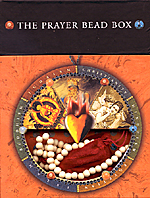Prayer beads have been used by Hindus, Buddhists, Muslims, and Christians for centuries as a devotional tool in prayer, meditation, and inner work. The number of beads and the ways in which they are used differ from one religion to another. As Manuela Dunn Mascetti and Priya Hemenway point out: "Counting prayers while fingering beads is a universal use. The idea behind this lies in the nature of repetition that soothes like a lullaby. It is calming and introspective. Beads are also used in prayer with a sense of beseeching or asking, thus making prayer more proactive."
This box contains a hardcover book about the history and use of prayer beads in different traditions plus a string of 108 sandalwood beads in a velvet sachet. The authors discuss some of the word meanings lying behind this ancient spiritual practice. The Sanskrit name for prayer beads is "smarani," which means "remembrancer." Commonly they were called "japamala" or "muttering beads." Hindus today use the beads, strung together in a mala, to perform japa, or repetition of a mantra.
Muslims call their strings of 99 prayer beads "tasbih," which means "to exalt" or "to praise." The believer repeats one of the names of God or another significant Arabic phrase while fingering the beads.
Early Christian beads were called "Paternosters" since they were used in repetitions of the Lord's Prayer. Later they became more known as rosaries, a word derived from the Latin for rose garden, a place of prayer. The "Hail Mary" prayer to the Virgin Mary is now recited by Catholics using a circle of beads divided into five groups of ten.
"Trengwa" is the word that the Tibetan lamas use for their prayer beads. It means "to purr like a cat — an organic drone that releases the mind into detachment."
Whether you use your prayer beads while chanting a mantra, reciting the names of Allah, saying the Hail Mary, or just using them to ward off anxiety as many Greeks do, you will find that this practice can enrich your devotional life, providing healing energy to your days.
